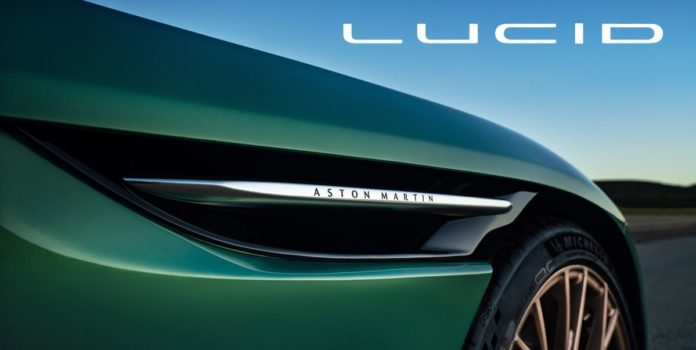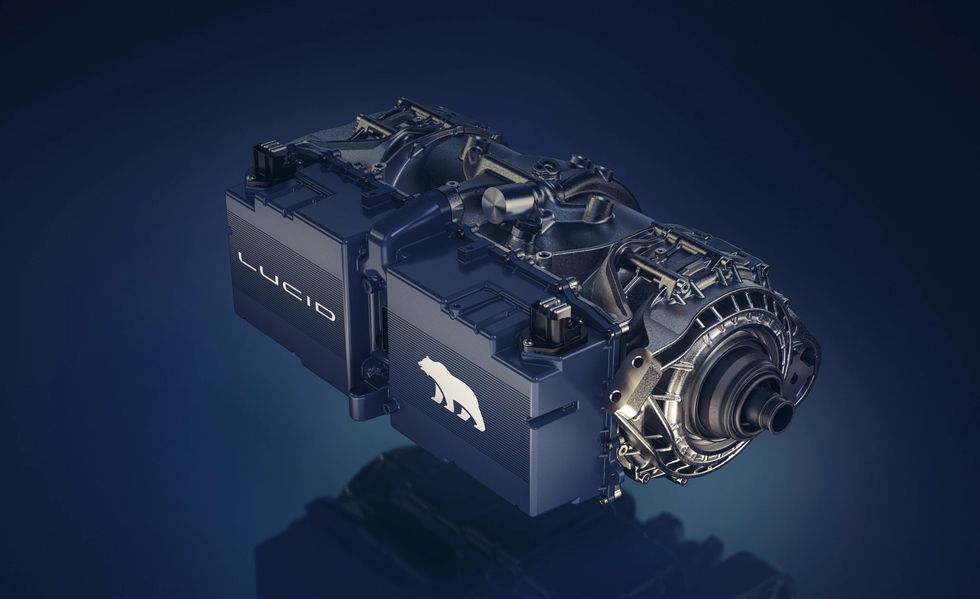- Aston Martin and Lucid are partnering up, with Aston’s future EVs set to use Lucid’s next-gen electric motors.
- An SUV and three sports cars are part of Aston’s EV plans, and some models could offer up to 1500 horsepower.
- The first Aston Martin EV is set to arrive in 2025.
The news surrounding Aston Martin over the last few years has often felt like an automotive soap opera. In the last five years, the British sports-car maker has gone through a poorly received IPO, parted ways with two CEOs, and gained an increasing number of co-owners. Both Mercedes-Benz and Chinese giant Geely acquired stakes alongside the consortium led by Canadian billionaire Lawrence Stroll, who is now also Aston’s executive chairman.
But now Aston has gained another equity partner as it looks towards an electric future, signing a deal with Lucid that will see the U.S. EV maker supply much of the technology for Aston’s forthcoming range of fully electric models. The first is promised for as soon as 2025. In return, Lucid Motors will be paid $132 million in cash for its expertise and will also be given a 3.7 percent stake in Aston Martin worth another $100 million. It is also guaranteed that Aston will buy at least $225 million in powertrain components.
Speaking to journalists at the company’s Gaydon HQ this afternoon, Stroll said that taking control of Aston proved proved to be the biggest challenge in his career. “Some of which I understood, some of which I clearly didn’t,” he admitted. The issues included dealing with excess inventory—shutting down production for nearly a year—and then raising the money required to develop new models, with this including a technology supply agreement with Mercedes.
That deal included both the AMG-sourced V-8 engines and Mercedes electronic architecture that Aston is already using, but also made provisions for a deeper agreement that would see Aston’s future EV models being based on Mercedes expertise. That prospect has effectively ended with the new Lucid deal, although Stroll was quick to point out that the existing Mercedes partnership for pure combustion and hybrid powertrains will continue.
Aston first tried to build an EV with the RapidE sedan nearly 10 years ago. This was intended for a limited production run, although only a single demonstrator was constructed. Subsequently the company planned to create a new EV platform to underpin Lagonda-branded models, although those were abandoned when it ran into its first financial crisis. But with luxury rivals including Bentley, Lamborghini, and Rolls-Royce working on electric models, Lucid’s expertise would seem to offer Aston a potential shortcut to what could be segment-leading performance.
No electric Aston will be short on urge. The forthcoming triple-motor Lucid Air Sapphire is set to have more than 1200 horsepower, but Lucid Group CEO Peter Rawlinson confirmed at the Aston briefing that the deal is actually for the company’s next-generation electric-motor technology. Aston CTO Roberto Fedeli said that Aston is working on what will become its own scalable EV platform that is set to feature similar bonded aluminum construction to the technique that underpins the company’s combustion models. But Lucid will supply both the twin rear motors and the compact battery cell technology that will allow low packs to be created to suit Aston’s sleek designs.
Fedeli told journalists that Aston is working to develop its own front motors, with the EV set to use versions of the ones that will feature in the forthcoming mid-engined plug-in-hybrid Valhalla hypercar. He also said the company is working on an active drag reduction technique in collaboration with the Aston Martin Formula 1 team, one that sounds like the “streamline mode” of the GMA T.50. A quad-motor layout will allow torque vectoring at both ends, and the prospect of a peak power output beyond 1500 hp.
Aston is also planning multiple EV models. The first of these will likely be a sleek SUV given the dynamics of the luxury market. Beyond that, Stroll confirms the plan is to create differently sized EVs similar to the brand’s three different front-engined sports cars. But, these won’t be electric versions of combustion models like the Maserati GranTurismo Folgore. It’s no wonder that Aston is also planning to radically revise its retail experience by opening company-owned flagship stores, the first in New York; they will need plenty of floor space just to show the full lineup.
Before the arrival of the first EV in 2025, Aston has already confirmed it will have replaced all of its existing sports cars with fresh models; the already announced DB12 is set to be joined soon by replacements for both the current Vantage and DBS. We can also expect a revised DBX which will include the option of a plug-in hybrid, with the Valhalla set to arrive next year as well. Before that, we’re also set to see an ultra-limited model created to celebrate Aston’s 110th anniversary this year.
Most important is the improving financial situation. Aston’s revenue has more than doubled between 2020 and 2022, with Stroll predicting that the company will become “cashflow positive” next year—bringing in more money than it is spending.
Could Aston Martin’s roller-coaster fortunes be set for the biggest climb yet?
This content is imported from poll. You may be able to find the same content in another format, or you may be able to find more information, at their web site.

European Editor
Mike Duff has been writing about the auto industry for two decades and calls the UK home, although he normally lives life on the road. He loves old cars and adventure in unlikely places, with career highlights including driving to Chernobyl in a Lada.



